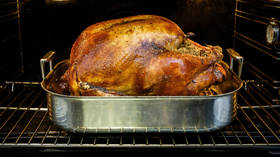46,000,000 turkeys consumed: How much energy do Americans use on Thanksgiving?
27 Nov, 2019 08:20 / Updated 4 hours ago

So, while we spend time being thankful this Thursday as we gather around the dinner table with family and friends, we should take a moment to extend that thanks to the energy that will be consumed making the turkey and all the trimmings.
But you might be surprised to know that Americans consume far less energy on Thanksgiving than on just any old Thursday—despite the fact that turkeys take nearly all night in the oven to cook.
Thanksgiving by the numbers
Size Matters
Americans aren’t the only ones with a weight problem; turkeys are getting a bit too big for their britches, too. The average Thanksgiving turkey size in 2019 is 30 pounds! That’s one big bird, and more than double from the 13 pound average sold in the 1930s. The fact that turkeys have bulged into enormous proportions means that it takes longer to cook. A 30-pound bird (stuffed, or course, because who doesn’t like in-the-bird stuffing?) can take 6.25 hours to cook in a 350° oven. The unstuffed equivalent takes about 1.25 hours less time to roast.
The Electric Cost of Roasting Each Tom
We did the math, and the average electric oven (non-convection) of the 2000-2400-watt variety will chew through a little over 12 kWh of electricity to cook that tom for 6 hours. At an average cost of 13.3 cents per kwh for electricity in the United States, turkey cookers will pay about $1.60 for the electricity to cook their birds (a couple of pennies more if you keep peeking at it while its cooking).
All Together Now
Americans will consume a staggering 46,000,000 turkeys this Thanksgiving. At 12 kWh each, that’s 552,000,000 kWh—for a single meal. That’s surely a large number.
Now, not everyone has an electric oven, so there’s that. About 63 percent of American homes have electric ovens, according to 2018 EIA data (with 33 percent using natural gas and five percent using propane), so this 552,000,000 kWh can be reduced to just 347,760,000 kWh. This could also be expressed as 347 gigawatts. That’s the equivalent of all the nuclear power capacity of the entire world in 2012, according to the IAEA, or the entire coal capacity installed in America in 2011.
Gobble it up!
But fret not. You can eat your turkey in good conscience—you’re actually doing your part to save the environment by eating the turkey. And here’s why:
An estimated 88 percent of all Americans eat turkey on Thanksgiving. There are 327,000,000 people living in America, so this means that 287,760,000 people eat turkey on Thanksgiving—but only 46,000,000 of those turkey eaters have the dual role of turkey eater and turkey roaster.
ALSO ON RT.COMDemocrats just accidentally sparked a federal fracking boom
That means that the remaining 241,760,000 people in America are your freeloading family members that are coming to your house to eat your turkey. And if those people are all at your house to eat your turkey, what are they not doing that they would be doing on any other day? Cooking, of course!
So, while cooking a turkey may seem an electrical extravagance, people are consolidating, so it actually is more of an energy savings than an indulgence, because fewer people are cooking that day—a lot fewer.
Other Thanksgiving Day energy considerations
Also, while families are together on this day waiting for the turkey to be done, fewer TVs are playing the requisite football games. Less energy.
More people are traveling. More energy. According to Gas Buddy, 65 percent of Americans travel by car. Gasoline inventories in the US rose last week, but gasoline prices are holding pretty steady compared to the last three thanksgivings.
Other energy is consumed in greater quantities on Thanksgiving as well, for preparing the rest of the holiday feast such as pumpkin pie, green bean casserole and mashed potatoes—three very critical Thanksgiving must-haves. All these trimmings likely add another couple million kWh to the energy draw for Thanksgiving.
ALSO ON RT.COMOn Thanksgiving, Trump says he is most thankful for …Trump
Residential heating. Less energy. As people are grouped into fewer abodes on Thanksgiving Day, heating sources are turned down or off while they stay with family—sometimes for days if they have traveled significant distances. This decreases the amount of energy used for heating.
Estimates are that energy usage typically drops 5-10 percent on Thanksgiving Day, compared to the November average, all thanks to that delicious turkey. And the estimated savings of that energy could amount to more than $2 billion in energy bills.
So, with conscience clear, travel to visit your family. Roast that bird. Eat well and be merry. Your overindulgence on Thanksgiving Day will balance out in the end, saving more electricity than you consume.
This article was originally published on Oilprice.com

0 Comments:
Post a Comment
Subscribe to Post Comments [Atom]
<< Home